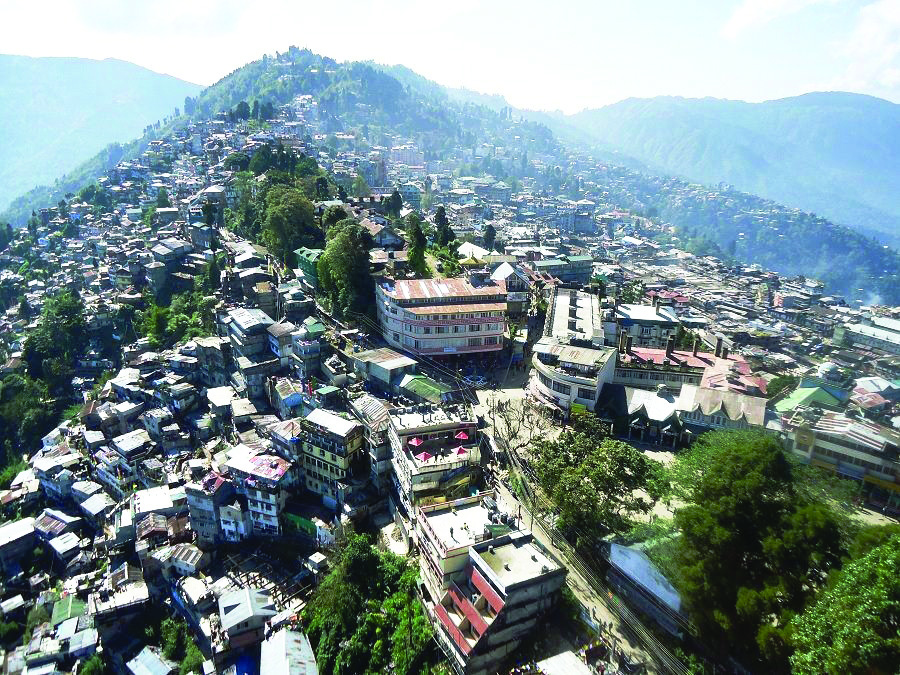
Darj-Sikkim: ‘Himalayan thrust slipping at the rate of 18 mm/yr’
Amitava Banerjee | MP | 7 Feb 2023 | Darjeeling: The 7.8 Turkey-Syria killer quake that has left more than 4 thousand dead is being read as a wake-up call for Darjeeling. The unplanned and unchecked urbanisation in the Darjeeling Hills that falls in the 4 to 5 seismic zone makes it a sitting duck.
Chief Minister Mamata Banerjee has also been repeatedly complaining about this unchecked menace. Though Darjeeling has witnessed frequent seismic activity coupled with landslides, illegal constructions continue unbridled in the Hills.
Though the stipulated norm for the height of a building is 11.5 m, most of the buildings have touched the 25m to 30 m mark. Heavy constructions have come up on steep gradients also. With hardly any space left for horizontal expansion, the Hill-town has taken to unchecked vertical expansion.
A paper published by Professor Malay Mukul and his research group from IIT Bombay in the Journal of Structural Geology in 2018 states that the Main Himalayan thrust in the Darjeeling-Sikkim Himalaya is slipping at the rate of 18 mm/yr according to the GPS data of the region between 1998-2012.
The study adds that because of this, the region is ripe for a major and even a great earthquake (8 or greater than 8 magnitude) along the Main Himalayan thrust at the depth of around 20 km with an epicentre between Gangtok and Lachen in Sikkim.
The seismic hazard in the Himalayas is inherently natural and the only thing that can be done is to build and live in structures that can withstand great earthquakes. Concrete slabs seem to be dangerous as they stack up in collapsed structures, trapping humans in between.
Rescue efforts involve heavy machinery to reach the collapsed structures and move the slabs. In hilly regions, getting such heavy machinery would also be challenging because of landslides during the earthquake and the lack of wide roads.
Experts opine that though earthquakes cannot be prevented as it is a natural phenomenon, the extent of damage can be minimised by investing in earthquake-resistant construction and also retrofitting existing buildings to make them earthquake-proof.
“A catastrophe of enormous magnitude is just waiting to happen and we are neither prepared nor equipped to tackle it. We are in 4 to 5 in the seismic zone. Building rules have to be imposed stringently. Constructions cannot be allowed on slopes more than 40 degrees. Rock detailing along with Slope Aspect Analysis has to be done for all constructions,” stated Dr Mamata Desai, Environmentalist and Geographer.
She has worked on landslide hazard management, specially in Darjeeling and Sikkim Himalayas for over 25 years. Slope Aspect Analysis determines whether the slope is north or south facing which in turn determines the rock or soil type and vegetation.
The previous Municipality board run by the Hamro Party had attempted to rein in illegal constructions. “We had earmarked 46 buildings and in the first phase sent notices to 9. Out of the 9 we had taken action against 5 and the matter reached court for 5 constructions,” stated Ritesh Portel, former Chairman.
“We are serious about this grave issue. We do not want to launch a political gimmick, rather we will indulge in realistic politics. Building rules and regulations like soil testing are being implemented stringently. We have decided to consult geologists and experts to come up with a concrete plan for future course of action,” stated Deependra Thakuri, Chairman, Darjeeling Municipality.
At present the board is run by the Bharatiya Gorkha Prajatantrik Morcha.
Courtesy & source- Millennium Post
https://www.millenniumpost.in/bengal/darj-sikkim-himalayan-thrust-slipping-at-the-rate-of-18-mmyr-507887

0 Response to "Darj-Sikkim: ‘Himalayan thrust slipping at the rate of 18 mm/yr’ "
Post a Comment
Disclaimer Note:
The views expressed in the articles published here are solely those of the author and do not necessarily reflect the official policy, position, or perspective of Kalimpong News or KalimNews. Kalimpong News and KalimNews disclaim all liability for the published or posted articles, news, and information and assume no responsibility for the accuracy or validity of the content.
Kalimpong News is a non-profit online news platform managed by KalimNews and operated under the Kalimpong Press Club.
Comment Policy:
We encourage respectful and constructive discussions. Please ensure decency while commenting and register with your email ID to participate.
Note: only a member of this blog may post a comment.